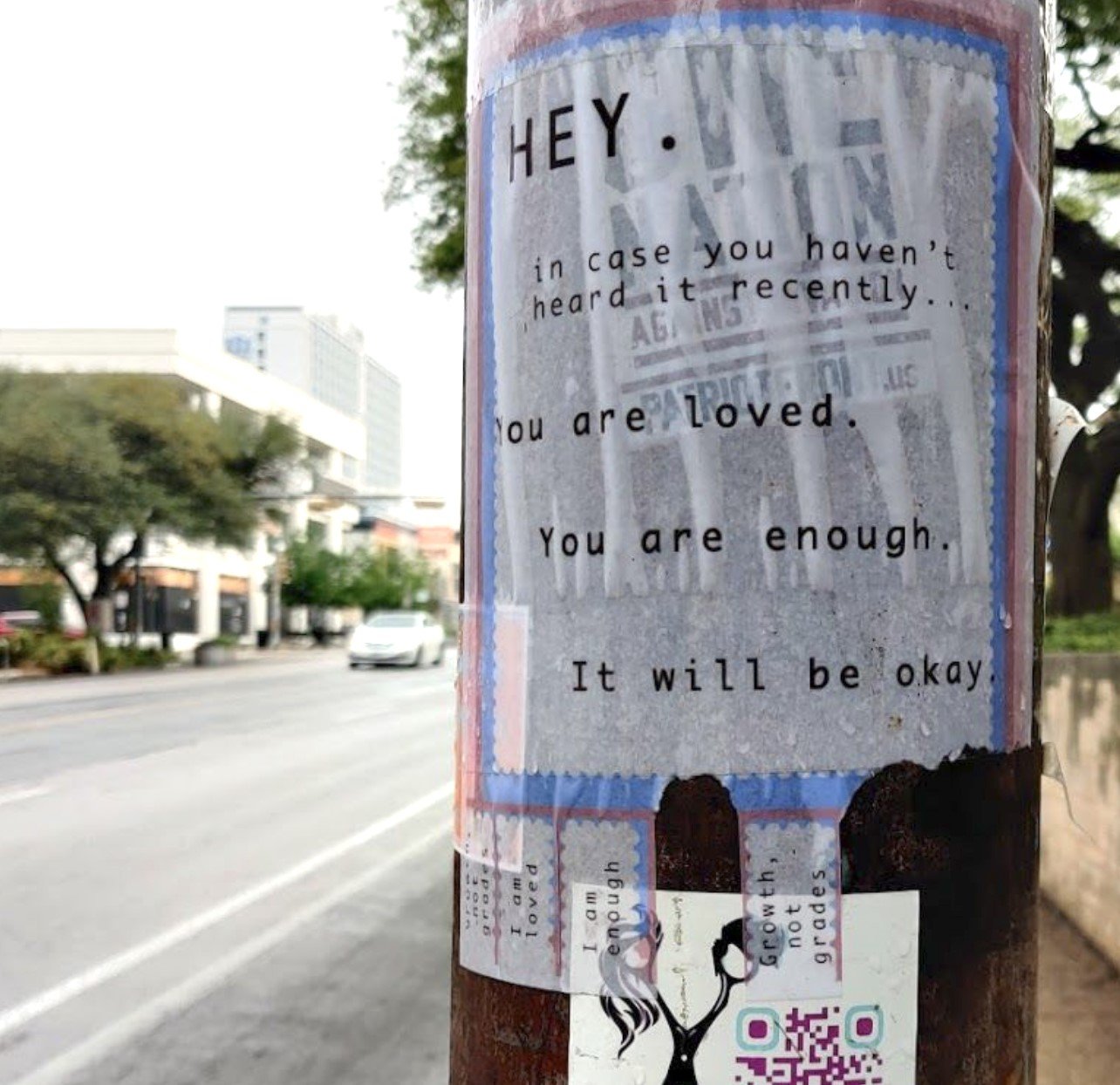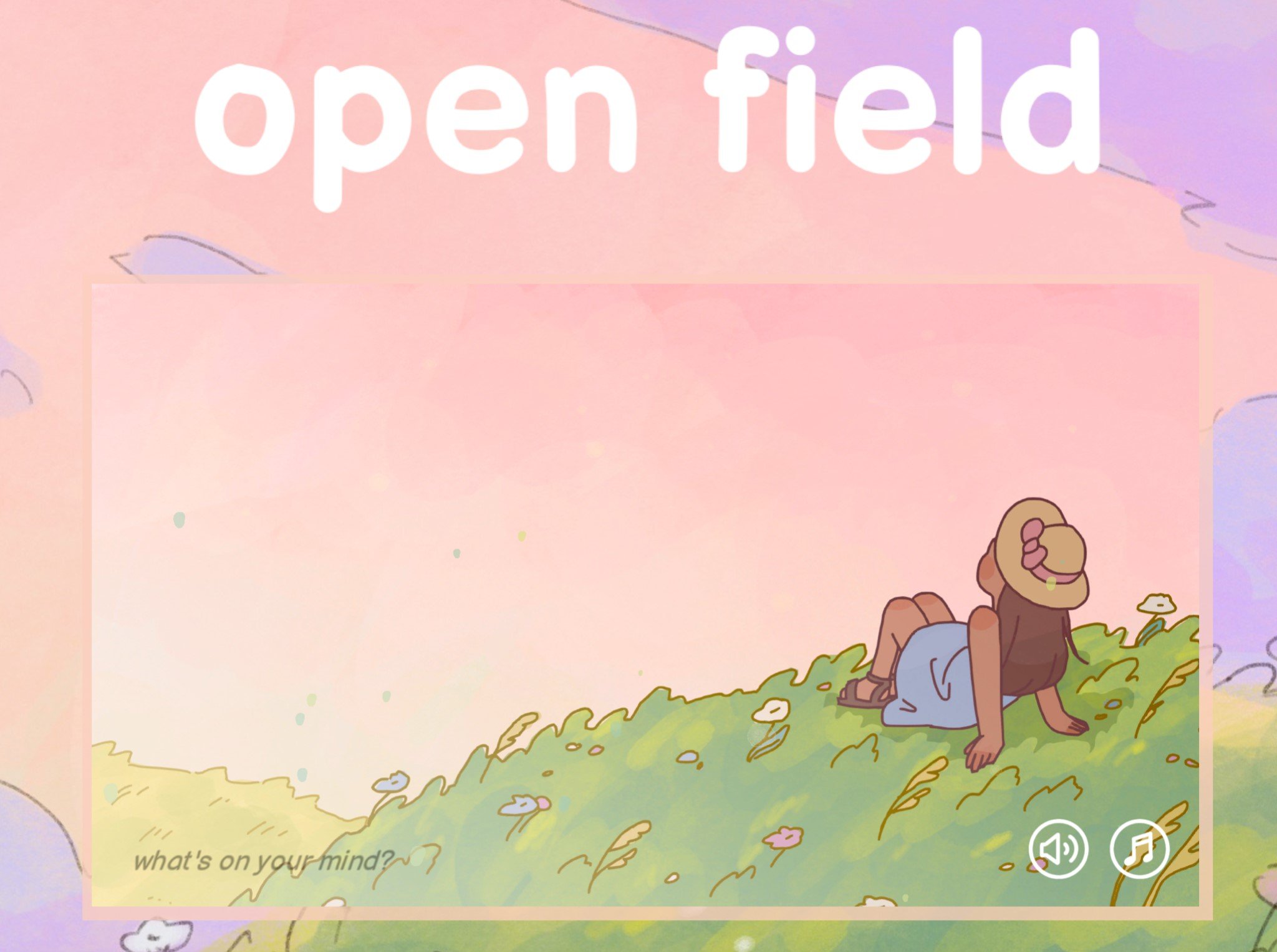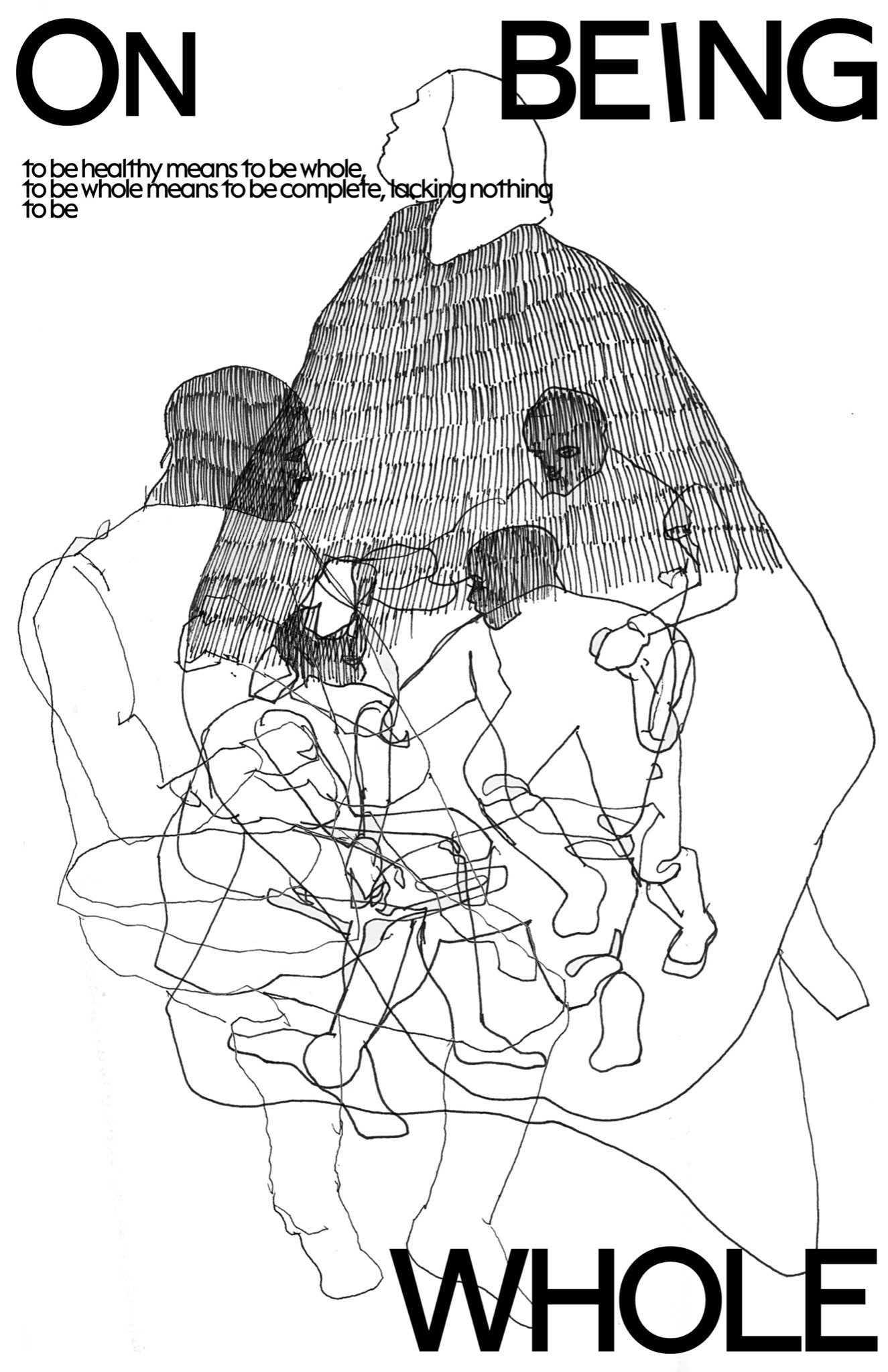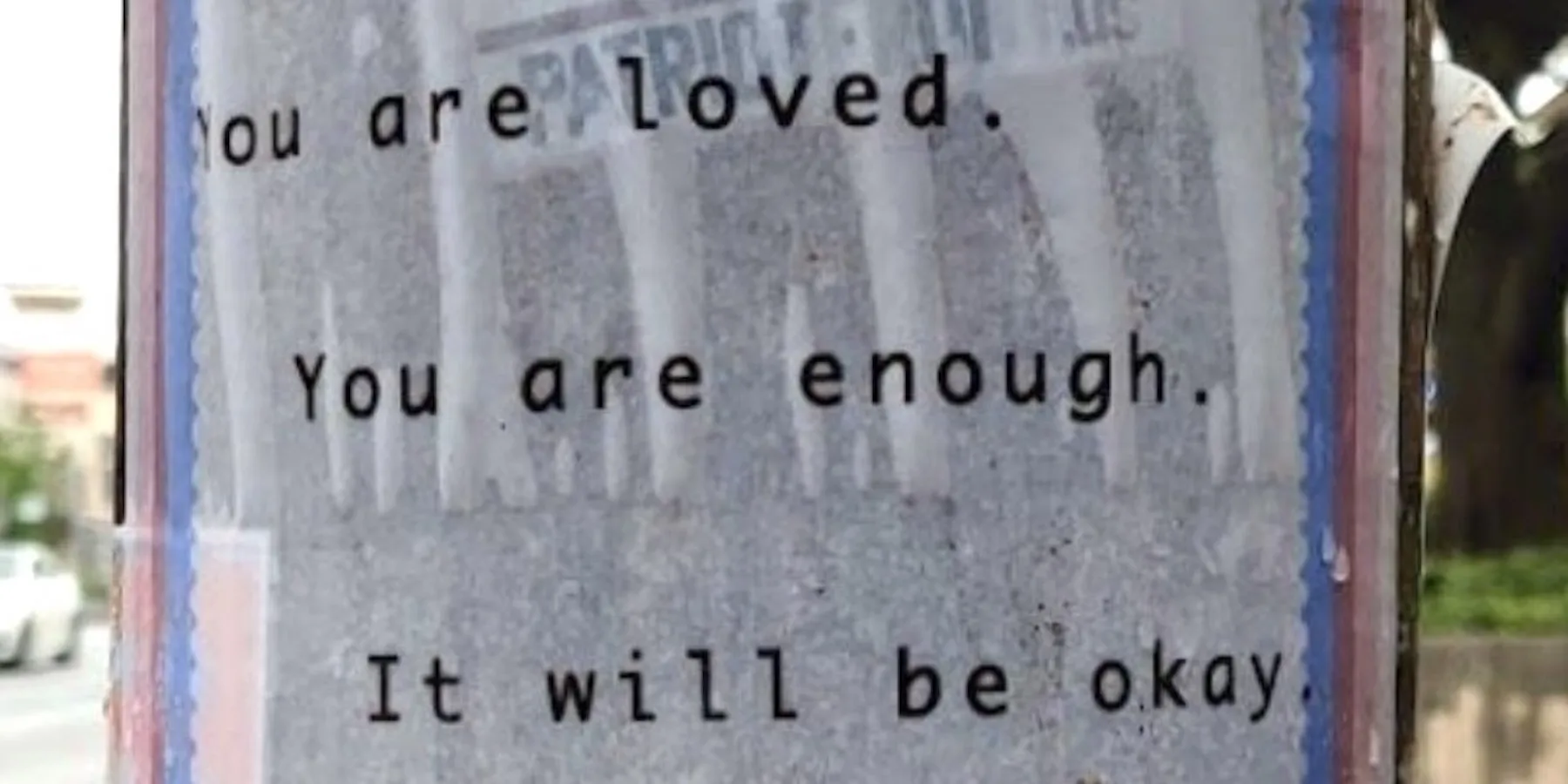Abstract
Background: The Aesthetics of Health (AOH) undergraduate visual art studies course at the University of Texas at Austin aimed to enhance art students’ awareness of cancer’s impact not only medically but also socially, emotionally, financially, and spiritually and to examine how this experience might impact students’ artwork, capacity for empathy, and connection to audience.
Methods: During the spring 2021 semester, the AOH course instructors employed assorted pedagogical methods, including art, illness narrative, and community engagement, in special sessions led by professors, community practice artists, and cancer experts, respectively, as well as oral storytelling by those with lived experience of cancer (ie, cancer patients, posttreatment survivors, and loved ones). For the course’s final project, the 15 student-artists created self-selected media works combining health and activism and displayed them in public spaces, including online. Student-artists took the Toronto Empathy Questionnaire during the first and last weeks of the course and provided feedback. Two group interviews were also held with cancer storytellers following their participation.
Results: Student-artists’ average score on the Toronto Empathy Questionnaire increased from 52.46 at pretest to 55.38 at posttest. Student-artists and storytelling participants also reported having positive experiences.
Conclusions: The AOH course’s social practice approach encouraged student-artists to realize new ideas and relationships and modestly increased their capacity for empathy. The AOH framework demonstrates promise for increasing empathy through the arts in other educational, clinical, and artistic institutions. Further research is needed with larger sample sizes to measure the impact of the course and to demonstrate its potential for addressing burnout and moral distress.
Background
In January 2021, the first author (M.H.), a young adult cancer survivor, artist, and professor, launched the Aesthetics of Health (AOH) course for 15 undergraduate visual art students at the University of Texas at Austin’s College of Fine Arts in collaboration with Dell Medical School’s Livestrong Cancer Institutes to enhance student-artists’ awareness of cancer’s impact on patients, survivors, and loved ones not only medically but also socially, emotionally, financially, and spiritually. The authors questioned how this experience might impact students’ artwork, capacity for empathy, and connection to audience.
Guest lecturers introduced student-artists to the course’s guiding theme, social practice art. According to social practice artist, author, and AOH guest lecturer, Ellen Mueller, social practice art is community-engaged, participatory, and activist art that exists in varying forms and on a spectrum of social engagement.1 Ezra Benus, another social practice artist and guest lecturer, explored with the class how static understandings of health keep resources from those who do not fit into normative understandings of illness because of age, race, gender expression, or diagnosis.2
Methods
Course design. The course enrolling 15 student-artists met for 3 hours, twice per week from January to May 2021. The multidisciplinary course focused on art, led by the professor; illness narrative and social practice, led by professional art activists; and community engagement methods, led by public health experts. Supplemental trainings were also offered, including patient privacy, provided by a legal expert, and palliative, supportive, and psychosocial care, provided by an oncology clinical social worker and a palliative physician. Professional mental health support was also offered throughout the semester.
Eight individuals who were actively in cancer treatment, were posttreatment survivors, or were loved ones of those with cancer joined the class over Zoom to participate in oral storytelling (one abridged session is on YouTube3). These storytellers with diverse cancer experiences work with the authors through the Livestrong Cancer Institutes’ patient and family advisory boards, codesigning oncology support programs and clinical services.4,5 Stories told to the student-artists included a Latinx patient’s delayed breast cancer diagnosis, despite her family history of hereditary cancer; a patient with a rare blood cancer suffering through chemotherapy without access to pain management; and a young adult with colorectal cancer who worked throughout treatment due to opaque disability eligibility guidelines.
Throughout each of the 8 storytelling sessions, the 15 student-artists in the course engaged with the storytellers, asking questions, creating each storyteller’s portrait in varying media, and sharing their in-process portraits. After conversing with those affected by cancer and gaining a foundational understanding of social practice art, student-artists were required for the course’s final project to reflect on health and health care in their lives and to create a work that combined health and activism. Student-artists created pieces in the studio and installed them in public spaces, including online.
Data collection and analysis. A mixed-methods approach was used to evaluate the course’s impact on student-artists and storytellers. The Toronto Empathy Questionnaire (TEQ), a validated self-reported 16-question tool with a 0 to 64 score range, was administered to student-artists in the first and last weeks of the course, and the average scores were compared to assess changes in empathy. Student-artists also provided written feedback to the professor about the course via a Likert scale and comments, and anonymous survey data were collected as part of a standard course evaluation, the results of which were shared with the professor following grade submissions. Two group interviews were held with storytellers following their participation.
Results
Student-artist projects. The pandemic was both a subject of and context for projects. Project themes included personal approaches to audience connection; addressing heavy, complicated issues with compassion and lightness; and acknowledging the centrality of mental health to overall well-being. Returning to their pieces after installation required student-artists to observe public acceptance, indifference, or rejection. Below are 4 examples of student-artists’ work.
Figure 1. Mental Health Is Not Cosmetic, 2021, by Bee Cortez

Courtesy of the artist.
Media
Spray chalk on cement.
Bee Cortez approached their project through the lens of transgender rights, a movement to eliminate discrimination against the trans community. Leveraging the trans flag colors, Cortez applied gradient spray chalk with a hand-made stencil that read “Mental Health Is Not Cosmetic.” This piece was created when the Texas legislature was actively considering transphobic legislation.6 Cortez says: “This work is meant to be a blatant response: gender-affirming care is much more than cosmetic procedures. This care helps lower or eliminate dysphoria and plays a direct part in trans youths’ mental health.”
Figure 2. You Are Loved, 2021, by Elyse Garcia

Courtesy of the artist.
Media
Flier.
Exhibited during final exams, Elyse Garcia’s flyer attempted to promote self-compassion among members of the higher education community. Figure 2 shows one example of her work on campus that she used to cover a White supremacy sticker made visible here by rain. Garcia says: “This assignment took place when my friends and I were experiencing burnout from the pandemic. The work was intended to catch the eye and share affirmations that passersby can tear off and keep.”
Figure 3. Open Field, 2021, by Karina Teruya

Courtesy of the artist.
Media
Online game.
To support emotional well-being during the pandemic, Karina Teruya created a gaming platform, which she publicized on social media and which had 439 plays as of January 5, 2022. Hearing gentle music and seeing a calm animated outdoor scene, users can type worries or frustrations and watch their words slowly fade. The entered data is deleted and not accessible by the user, other users, or the artist. All users are anonymous, and the project is open media. Teruya says: “Nobody can read the messages so users can say what they want with no regrets and get weight off their chest.”
Figure 4. On Being Whole, 2021, by Nicholas Wong

Courtesy of the artist.
Media
Poster.
Using wobbly text to frame his piece, Nicholas Wong focused on overlapping bodies via contour lines depicting deep support and care. Wong, an art major and premed student, posted the image on his design studio’s Instagram account, @breather.studio, resulting in 66 likes and 37 comments as of January 5, 2022. He says: “Combining imagery from my studio practice with thoughts about health care, the piece considers what it means to be whole, what contributes to one’s well-being outside clinical spaces, and incorporating those qualities into health care infrastructure.”
Student TEQ scores, ratings, and comments. For the 13 student-artists who completed the TEQ twice, the average score increased by 2.92 from the semester’s beginning (52.46) and the end (55.38). Although this increase is modest, it should be noted that the average TEQ scores in validity studies range from 44.54 to 47.27,7 so the class average was above this range before the course.
The 15 student-artists also anonymously rated both the instructor and course, unanimously providing a top rating for both on a 5-point Likert scale. Some opted to provide comments (see Table).
| “The strongest element of the class was the focus moving outside of the studio practice and showing where else art can and does exist.” |
| “I found this class to be very engaging and enriching, with a variety of projects and teachings that provided me with an array of tools to approach ethics and empathy…. Approaching vulnerable notions of wellness and personal health was daunting but gradually became more accessible as time went on.” |
| “Aesthetics of Health taught me that it’s valuable to be aware of who you are making work for, what physical space it will be in, and any implications…. But we should still be making work for us and not get hung up on what we expect others to want from the work.” |
| “I undoubtedly experienced an increase of empathy by taking this course. The most effective part of the learning experience was the class culture: collaborative and supportive—all seeking to heal and be healed.” |
| “It really showed me that art can be used to comfort and help those around you and the person inside you.” |
| “The viewer is more important for my work now than they used to be. Now when I create art I think about who it is for and how it will be perceived.” |
| “This class tangibly introduces art into real world circumstances and we are invited to see its impact. It was one of the first times art school didn’t feel self-contained in its own bubble of discourse.” |
Storytellers’ comments. Those with lived experience of cancer also overwhelmingly had a positive experience. One commented: “The emotional response [from the student-artists] was something I didn’t expect. Having a discussion [rather than sitting for a portrait in silence] was really important. You could totally see the empathy that these students had, just in the way they asked questions ... and processing it all on their end.” Another shared: “I love the interpretations that they [the students] were able to grasp from this. It was really therapeutic.... It really helped me value it [my cancer story] more. For me, going through cancer didn’t feel like an important achievement ... but telling my story made me realize it is impactful.”
Conclusions
There is evidence that the AOH course modestly increased student-artists’ empathy and encouraged student-artists to actualize new ideas and relationships. Student-artists judged the strengths of the course to be its variety of projects and approaches, its collaborative and supportive environment, and its real-world impact. However, the class size (15 students) was small, and the course was only one academic semester long. Nevertheless, the AOH course’s experiential framework demonstrates promise for other educational, clinical, and artistic institutions to weave lived experience of health and health care into humanities curricula, examine healing in new ways, and explore the impacts of curricula on participants, including on capacity for empathy. Further research is needed with larger samples to measure the AOH course’s impacts and to demonstrate its potential for addressing burnout and moral distress.
References
-
Mueller E. Some Social Practice. Ellen Mueller; 2020.
-
Benus E. Ezra Benus. Accessed January 3, 2022. https://www.ezrabenus.com/
-
Aesthetics of health: scenes from Anmol's portrait. YouTube page. March 3, 2021. Accessed January 3, 2022. https://www.youtube.com/watch?v=S7QDIHKmwrY&t=1s
-
Community Cancer Advisory Board. UT Health Austin. Accessed January 3, 2022. https://uthealthaustin.org/clinics/cancer/community-cancer-advisory-board
-
Young Adult Advisory Board. UT Health Austin. Accessed January 3, 2022. https://uthealthaustin.org/clinics/cancer/young-adult-advisory-board
-
Munce M. Texas GOP's bills targeting transgender children have exacted a mental health toll, even if they don’t become law. Texas Tribune. May 23, 2021. Accessed January 3, 2022. https://www.texastribune.org/2021/05/23/texas-transgender-legislation-sports-health-care/
- Spreng RN, McKinnon MC, Mar RA, Levine B. The Toronto Empathy Questionnaire: scale development and initial validation of a factor-analytic solution to multiple empathy measures. J Pers Assess. 2009;91(1):62-71.




